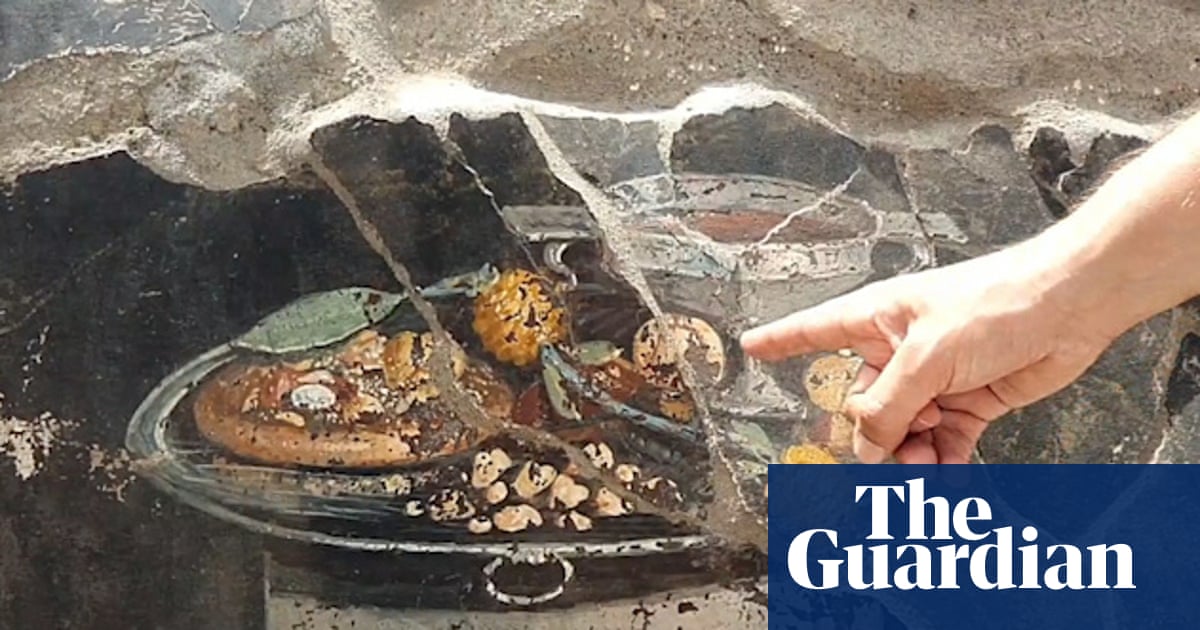
A striking still life fresco resembling a pizza has been found among the ruins of ancient Pompeii, although the dish seems to lack two essential ingredients – tomato and mozzarella – and includes an item that looks suspiciously like a pineapple.
The fresco, which dates back 2,000 years, emerged during excavations in the Regio IX area of Pompeii’s archaeological park, which is close to Naples, the birthplace of pizza. The painting was on a wall in what is believed to have been the hallway of a home that had a bakery in its annexe.
The fresco appears to depict a round focaccia bread on a silver tray serving as a support for various fruits, including a pomegranate and possibly a date.
However, the “pineapple” on the plate seems likely to be something else entirely, as the first European to encounter the fruit was Christopher Columbus, in Guadeloupe in 1493.
Experts say the bread is seasoned with spices or moretum, a herb cheese spread eaten by the ancient Romans. Next to the bread is a goblet of wine, along with dried fruit, dates, pomegranate and a garland of yellow arbutus.
The still life is thought to have been inspired by the Greek hospitality ritual of xenia, and so the tray represented gifts that were offered to guests as part of a tradition dating back to the Hellenistic period. Such images were widespread in the homes of ancient Pompeii and nearby Herculaneum, which were both wiped out when Mount Vesuvius erupted in AD79.
However, it is unusual to find such a fresco containing the image of a focaccia.
Gabriel Zuchtriegel, the director of Pompeii archaeological park, said the fresco appears to reflect the contrast between a “frugal and simple meal” and “the luxury of silver trays and refinement of artistic and literary representations”.
“How can we fail to think, in this regard, of pizza, which was also born as a ‘poor’ dish of southern Italy, which has now conquered the world and is also served in starred restaurants,” he said.
Naples is the home of the margherita, the traditional pizza comprising a simple mix of tomato, mozzarella, fresh basil and extra-virgin olive oil, and the notion of topping the dish off with fruit enrages many Italians.
But not so much Gino Sorbillo, owner of one of the oldest pizzerias in Naples, who is convinced that the image in the Pompeii fresco is, in fact, a pizza. “In ancient Pompeii we already knew that there were forms of flatbread, made with grains, water, salt and maybe beer as a leavening agent,” he said. “Then they might have topped it with vegetables or the fish of the day … it was an ancient form of pizza.”
He added that fruit might have been considered more of a main dish during the ancient Roman period. When it comes to fruit on pizza in modern times, he said: “You can use fruit, for example figs, or strawberries, if it’s a sweet pizza.”
But asked whether the fresco settled the argument for pineapple on pizza, Sorbillo responded with a resolute: “No.”
“Tastes are tastes,” he added. “We make traditional pizza and would never use pineapple.”
The eruption of Vesuvius killed an estimated 2,000 people. The ruins were discovered in the 16th century, with the first excavations beginning in 1748.
Excavations on Insula 10 in Regio IX, a district of the city that had hosted a cluster of homes, workshops and the bakery, began in February. The skeletal remains of three victims, two women and a child, were found in May in a bakery, where they were believed to have sought shelter. Frescoed walls featuring the mythical scene of Apollo and Daphne in one, and Poseidon and Amymone in the other, have also been discovered.
The remains of two other victims, thought to be two men in their mid-50s, were found in another part of the site in mid May. The men were believed to have been killed by an earthquake that accompanied the eruption of Vesuvius. One is thought to have raised his arm in an attempt to protect himself from a falling wall. Beads from a necklace and six coins, two dating back to the middle of the second century BC, were found nearby.
The Italian culture minister, Gennaro Sangiuliano, said Pompeii “never ceases to amaze”. “It is a treasure chest that always reveals new treasures,” he added.












